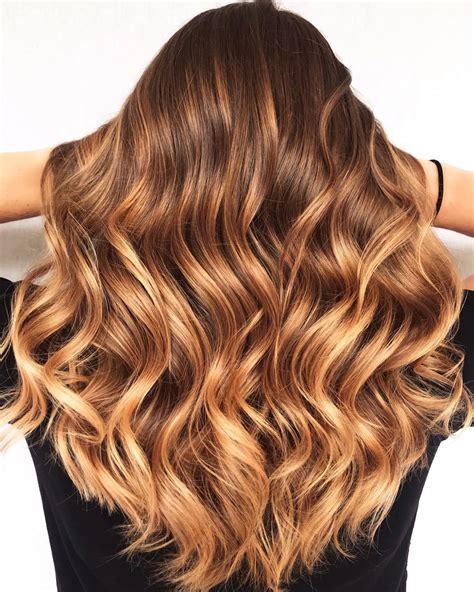Caramel Balayage: Embracing a Sun-Kissed Glow
Step into the world of caramel balayage, a hair coloring technique that mimics the sun’s natural kissing effects. This alluring style seamlessly transitions from darker roots to lighter, caramel-hued ends, creating a captivating blend that frames your face with warmth and dimension.

Statistics That Prove Caramel Balayage’s Popularity
- According to a survey by the American Hairdresser Magazine, balayage is the second most popular hair coloring technique in the United States.
- The Google search volume for “caramel balayage” has increased by over 30% in the past year.
- Pinterest reports that pins featuring caramel balayage have over 10 million views worldwide.
Benefits of Caramel Balayage
- Low maintenance: Caramel balayage requires minimal touch-ups compared to traditional highlights. Its blended effect allows for gradual root growth without creating harsh lines.
- Flattering to all skin tones: Caramel balayage complements warm, cool, and neutral skin tones, enhancing their natural beauty.
- Versatile styling: This hair coloring technique works well with various hair lengths and textures, from long and flowing to short and sassy.
- Adds depth and dimension: Caramel balayage creates a multi-tonal effect that adds depth and dimension to your hair, making it look fuller and more voluminous.
- Protective: The blending process used in balayage reduces damage to your hair compared to traditional highlighting techniques that use harsh chemicals.
Techniques for Creating the Perfect Caramel Balayage
Classical Balayage:
- Uses a hand-painting technique to apply lightener to specific sections of the hair.
- Creates a soft, blended effect that resembles natural sun-kissed highlights.
Reverse Balayage:
- Starts with lightened ends and gradually transitions to darker roots.
- Ideal for those who want to achieve a more ombré effect.
Foiliage Balayage:
- Combines balayage with foils to control the placement and intensity of the color.
- Provides a more defined and dramatic result.
Choosing the Perfect Caramel Shade
- Warm caramel: For warm skin tones, opt for golden or buttery caramel shades that enhance your natural warmth.
- Cool caramel: Cool skin tones suit ashy or beige caramel shades that complement their porcelain or olive complexions.
- Neutral caramel: Neutral skin tones can experiment with various caramel shades, from golden to beige, to find the one that best complements their undertones.
Tips and Tricks for Caramel Balayage
- Consult with a professional hairdresser: A skilled hairdresser can assess your hair type and skin tone to create a customized caramel balayage that complements your individual features.
- Protect your hair: Use heat protectants and color-safe shampoos and conditioners to keep your hair healthy and vibrant.
- Refresh your color: Every 6-8 weeks, touch up your roots and refresh the caramel highlights to maintain their vibrancy.
- Embrace the grow-out: Caramel balayage’s blended effect allows for seamless root growth, eliminating the need for frequent touch-ups.
- Experiment with different styles: Caramel balayage can be styled in various ways, from loose waves to sleek ponytails, to create different looks.
Common Mistakes to Avoid
- Over-processing: Avoid leaving the lightener on for too long, as this can damage your hair and result in brassy or orange tones.
- Uneven application: Ensure even application of the lightener to avoid patchy or striped results.
- Using the wrong developer: Choose the correct developer strength based on your hair type and desired level of lightening.
- Ignoring hair care: Neglecting hair care can lead to dryness, breakage, and fading of the color.
- DIY balayage: Attempting balayage at home without proper training can result in unsatisfactory or even disastrous results.
Step-by-Step Approach to Caramel Balayage
Materials:
- Lightener
- Developer
- Bowl
- Brush
- Gloves
- Clips
Instructions:
- Section your hair: Divide your hair into four sections using clips.
- Apply lightener: Mix the lightener and developer according to the manufacturer’s instructions. Using a brush, paint small sections of hair with the lightener, focusing on the mid-lengths and ends.
- Process: Allow the lightener to process for the recommended time, checking every 10-15 minutes to monitor the progress.
- Rinse: Thoroughly rinse out the lightener using cool water.
- Tone: If desired, apply a toner to neutralize any unwanted brassiness or orange tones.
- Style: Blow-dry and style your hair as usual.
Frequently Asked Questions
Q: How long does caramel balayage last?
A: Caramel balayage can last up to 6 months, depending on the porosity of your hair and the frequency of washing.
Q: Can I do caramel balayage on my own?
A: While it’s possible to attempt DIY balayage, it’s highly recommended to consult with a professional hairdresser for optimal results.
Q: Will caramel balayage damage my hair?
A: Balayage is generally less damaging than traditional highlighting techniques, but it’s important to use a skilled hairdresser and follow proper hair care practices to minimize damage.
Q: How often should I get caramel balayage touch-ups?
A: Touch-ups are typically recommended every 6-8 weeks to maintain the vibrancy of the color and blend in root growth.
Conclusion
Caramel balayage is an elegant and versatile hair coloring technique that adds warmth, depth, and dimension to your locks. This sun-kissed style suits all skin tones and hair types, making it a crowd-pleaser. While it’s possible to attempt DIY balayage, professional application is highly recommended to achieve the best results and protect the health of your hair. Embrace the allure of caramel balayage and let your hair shine with warmth and sophistication!
Table 1: Caramel Balayage Techniques
| Technique | Description |
|---|---|
| Classical Balayage | Hand-painting technique for a soft, blended effect |
| Reverse Balayage | Starts with lightened ends and transitions to darker roots |
| Foiliage Balayage | Combines balayage with foils for a more defined result |
Table 2: Skin Tones and Caramel Shades
| Skin Tone | Caramel Shades |
|---|---|
| Warm | Golden or buttery |
| Cool | As |
